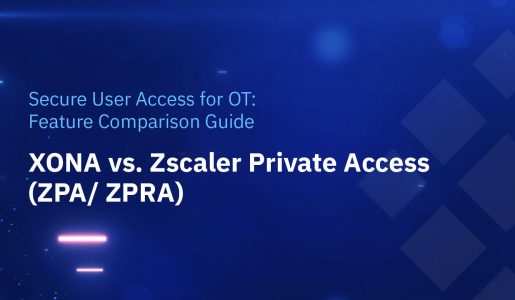Operational Cost & Complexity
Zscaler Private Access (ZPA/ZPRA)
Purpose-built for OT and Critical Infrastructure (CI)
XONA Systems
Best

Zscaler Private Access (ZPA/ZPRA)
Concerning

Simple to deploy. Intuitive to use. Set and forget.
XONA Systems
Best

Zscaler Private Access (ZPA/ZPRA)
Concerning

Frictionless 3rd-party access. Nothing required aside from a device with a modern browser supporting HTTPS.
XONA Systems
Best

Zscaler Private Access (ZPA/ZPRA)
Good

Deployment – Easy to Deploy
XONA Systems
Best

Zscaler Private Access (ZPA/ZPRA)
Concerning

Software must be staged on hardware, VM, or cloud
XONA Systems
Not Applicable

Zscaler Private Access (ZPA/ZPRA)
Concerning

Network/Firewall modifications required
XONA Systems
Not Applicable

Zscaler Private Access (ZPA/ZPRA)
Good

Agent (vendor) required
XONA Systems
Not Applicable

Zscaler Private Access (ZPA/ZPRA)
Worst

User/operator must install proprietary client application for full solution functionality
XONA Systems
Not Applicable

Zscaler Private Access (ZPA/ZPRA)
Worst

Time required to install
XONA Systems
Best

Zscaler Private Access (ZPA/ZPRA)
Worst

Usability
XONA Systems
Best

Zscaler Private Access (ZPA/ZPRA)
Good

Manageability
XONA Systems
Best

Zscaler Private Access (ZPA/ZPRA)
Good

Network Complexity
XONA Systems
Best

Zscaler Private Access (ZPA/ZPRA)
Good

Risk of losing access to OT Asset
XONA Systems
Best

Zscaler Private Access (ZPA/ZPRA)
Good

Zero Trust Approach
Zscaler Private Access (ZPA/ZPRA)
Authentication (e.g., 1FA, 2FA/MFA, SAML 2.0)
XONA Systems
Best

Zscaler Private Access (ZPA/ZPRA)
Best

Authorization – Enforces least privilege
XONA Systems
Best

Zscaler Private Access (ZPA/ZPRA)
Best

User access is limited to specific OT/CI systems
XONA Systems
Best

Zscaler Private Access (ZPA/ZPRA)
Best

User access is limited to specifics dates and times
XONA Systems
Best

Zscaler Private Access (ZPA/ZPRA)
Best

Cybersecurity
Zscaler Private Access (ZPA/ZPRA)
Data Stream Protection
XONA Systems
Best

Zscaler Private Access (ZPA/ZPRA)
Not Applicable

Secure File Transfer
XONA Systems
Best

Zscaler Private Access (ZPA/ZPRA)
Good

OT Protocol Isolation
XONA Systems
Best

Zscaler Private Access (ZPA/ZPRA)
Not Applicable

Risk Introduced based on external dependencies
XONA Systems
Not Applicable

Zscaler Private Access (ZPA/ZPRA)
Good

Key Features & Functionality
Zscaler Private Access (ZPA/ZPRA)
User/Operator Session Monitoring
XONA Systems
Best

Zscaler Private Access (ZPA/ZPRA)
Worst

User/Operator Session Recording (video)
XONA Systems
Best

Zscaler Private Access (ZPA/ZPRA)
Worst

Compliance support for key OT regulations such as ISA99/IEC 62443, NERC-CIP, NIST 800-53, and TSA SD02C
XONA Systems
Best

Zscaler Private Access (ZPA/ZPRA)
Best

High Availability Option
XONA Systems
Best

Zscaler Private Access (ZPA/ZPRA)
Best

Log Management Integrations (e.g., SIEM, etc.)
XONA Systems
Best

Zscaler Private Access (ZPA/ZPRA)
Best

Incident Management Integrations
XONA Systems
Good

Zscaler Private Access (ZPA/ZPRA)
Good

Conclusion
In evaluating secure user access solutions for OT/CI, it’s important that the solution be flexible enough to address the operational needs and constraints of the environment into which it will be deployed, supports a zero-trust authentication and authorization model, and brings a high degree of security to the OT environment into which it needs to connect.
Zscaler Private Access (ZPA) content includes claims that the product provides “fast, direct, secure access to industrial systems and devices.” That it provides “frictionless” access, and that it supports the needs of OT. What it doesn’t state is that the implementation of the product could take weeks, if not months. That the “frictionless” access is both conditional (i.e., non-managed devices only) and feature limited (i.e., it doesn’t support the file transfers required for contractors or vendors to patch/update systems) and that the operators of most OT environments do not want to be tied to a cloud and require core functionality such as system monitoring and recording – something that Zscaler can’t do.
In contrast, the XONA Critical System Gateway (CSG) enables frictionless employee, contractor, and/or vendor access that’s purpose-built for operational technology (OT) and critical infrastructure (CI).
The CSG is the definition of simplicity and can be deployed in less than an hour. It’s approach to data stream protection and protocol isolation mitigates the risk of connecting to a protected OT network, and eliminates common attack vectors, while reducing the overall attack surface. It also enables compliance with OT-specific regulations such as ISA99/IEC 62443, NERC-CIP, NIST SP 800-207, NIST 800-53, and TSA SD02C.
XONA CSG is your secure portal into the cyber-physical world that enables critical operations to happen from anywhere with total confidence and trust.
All company and product names, logos, trademarks, service marks and branding are the property of their respective owners. All company, product and service names used in this document are for identification purposes only. Use of these names, logos, and brands does not imply endorsement or criticism. The information included in this document/web page was gathered from publicly available sources and based on our opinion from our research and technical evaluation. This document is intended for general informational purposes.




